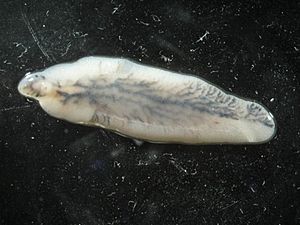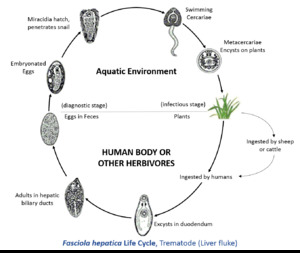Common liver fluke facts for kids
Quick facts for kids Fasciola hepatica |
|
|---|---|
 |
|
| Fasciola hepatica – adult worm | |
| Scientific classification | |
| Kingdom: | |
| Phylum: | |
| Class: | |
| Subclass: | |
| Family: |
Fasciolidae
|
| Genus: |
Fasciola
|
| Binomial name | |
| Fasciola hepatica Linnaeus, 1758
|
|
Fasciola hepatica, also known as the common liver fluke, is a tiny parasitic worm. It is a type of trematode, which is a flatworm. These worms live inside other animals and get their food from them.
This parasite mainly infects the liver of different mammals. This includes animals like sheep, cattle, and even humans. The sickness caused by this worm is called fascioliasis. It is considered a "neglected tropical disease." This means it affects many people in certain parts of the world but doesn't always get a lot of attention.
F. hepatica is found all over the world. For hundreds of years, it has been a major problem for sheep and cattle farmers. It can cause big financial losses because animals get sick. Because it is so common and important, scientists have studied it a lot. It is one of the most well-known types of flatworms.
Contents
What is Fasciola hepatica?
Fasciola hepatica is a flatworm that looks a bit like a leaf. Adult worms can grow up to 3 centimeters (about 1.2 inches) long. They have a flat body and two suckers. One sucker is at the front, near its mouth. The other is on its belly. These suckers help the worm attach itself inside the host animal.
The worm lives in the bile ducts of the liver. Bile ducts are small tubes that carry bile, a liquid that helps digest food. The worm feeds on blood and liver cells.
How the Liver Fluke Spreads (Life Cycle)
The life of Fasciola hepatica is quite complex. It involves several stages and two different hosts. A host is an animal that a parasite lives in.
Stage 1: Eggs in Poop
The adult worms live in the liver of infected animals. They lay many tiny eggs. These eggs leave the animal's body through its poop. For the eggs to hatch, they need to land in fresh water.
Stage 2: Miracidia Hatch
If the eggs are in water and the temperature is right, they hatch. A tiny, swimming larva called a miracidium comes out. This miracidium has small hairs called cilia. These hairs help it swim around in the water.
Stage 3: Finding a Snail
The miracidium must find a specific type of freshwater snail very quickly. If it doesn't find a snail within a few hours, it will die. Once it finds a snail, it burrows into the snail's body.
Stage 4: Growing Inside the Snail
Inside the snail, the miracidium changes. It becomes a sac-like stage called a sporocyst. The sporocyst then produces more larvae called rediae. These rediae then produce even more larvae called cercariae. This process takes several weeks.
Stage 5: Cercariae Leave the Snail
The cercariae are like tiny tadpoles with tails. They leave the snail and swim freely in the water. They look for plants growing in the water, like grass or watercress.
Stage 6: Attaching to Plants
The cercariae attach themselves to these plants. They lose their tails and form a tough outer shell. This stage is called a metacercaria. The metacercaria is like a tiny cyst. It can survive for a long time on the plants.
Stage 7: Infecting a New Host
Animals, like sheep or cattle, get infected when they eat these plants. Humans can also get infected by eating raw watercress or other water plants. They can also get it from drinking contaminated water.
Stage 8: Growing into Adults
Once inside the new host, the metacercariae hatch in the intestine. The young worms then travel through the body. They burrow through the wall of the intestine and move to the liver. In the liver, they grow into adult worms. The adult worms then start laying eggs, and the cycle begins again.
What is Fascioliasis?
Fascioliasis is the disease caused by Fasciola hepatica. In animals, it can cause weight loss and make them less productive. It can also lead to serious liver damage. This is why it causes big economic losses for farmers.
In humans, fascioliasis can cause fever, stomach pain, and an enlarged liver. If not treated, it can lead to long-term health problems. Doctors can usually treat it with special medicines.
How to Prevent Infection
Preventing fascioliasis mainly involves breaking the life cycle of the worm.
- For animals: Farmers can keep their animals away from wet, marshy areas where snails live. They can also treat infected animals to stop them from spreading eggs.
- For humans: It's important to avoid eating raw water plants from areas where the fluke is common. Always wash vegetables thoroughly. Also, avoid drinking untreated water from ponds or streams.
Images for kids
-
Galba truncatula, an amphibious freshwater lymnaeid snail that serves as the main intermediate host of Fasciola hepatica in Europe
See also
 In Spanish: Duela del hígado para niños
In Spanish: Duela del hígado para niños











